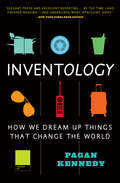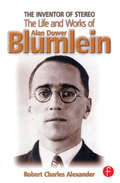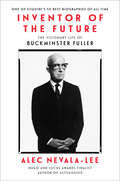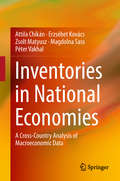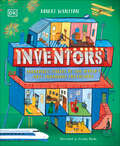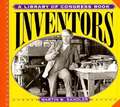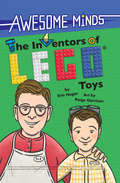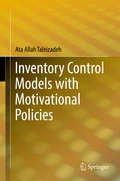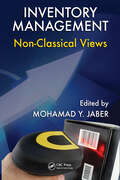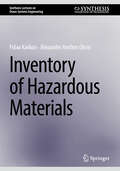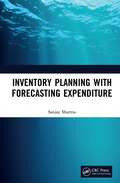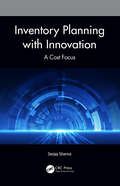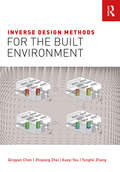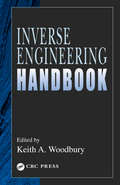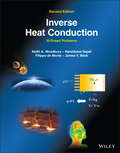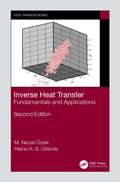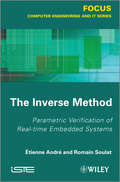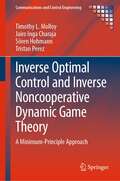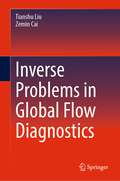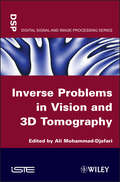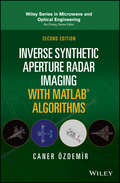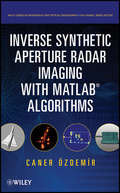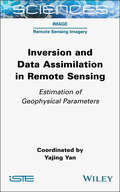- Table View
- List View
Inventology: How We Dream Up Things That Change the World
by Pagan KennedyFind out where great ideas come from in this &“delightful account of how inventors do what they do&” (Kirkus Reviews, starred review). A father cleans up after his toddler and imagines a cup that won&’t spill. An engineer watches people using walkie-talkies and has an idea. A doctor figures out how to deliver patients to the operating room before they die. By studying inventions like these—the sippy cup, the cell phone, and an ingenious hospital bed —we can learn how people imagine their way around &“impossible&” problems to discover groundbreaking answers. Pagan Kennedy reports on how these enduring methods can be adapted to the twenty-first century, as millions of us deploy tools like crowdfunding, big data, and 3-D printing to find hidden opportunities. Inventology uses the stories of inventors and surprising research to reveal the steps that produce innovation. Recent advances in technology and communication have placed us at the cusp of a golden age; it&’s now more possible than ever before to transform ideas into actuality. Inventology is a must-read for designers, artists, makers—and anyone else who is curious about creativity. By identifying the steps of the invention process, Kennedy reveals the imaginative tools required to solve our most challenging problems. &“There&’s ample interest here even for readers who aren&’t actively inventing anything.&” —The Boston Globe
The Inventor of Stereo: The life and works of Alan Dower Blumlein
by Robert AlexanderThis book is the definitive study of the life and works of one of Britain's most important inventors who, due to a cruel set of circumstances, has all but been overlooked by history. Alan Dower Blumlein led an extraordinary life in which his inventive output rate easily surpassed that of Edison, but whose early death during the darkest days of World War Two led to a shroud of secrecy which has covered his life and achievements ever since.His 1931 Patent for a Binaural Recording system was so revolutionary that most of his contemporaries regarded it at as more than 20 years ahead of its time. Even years after his death, the full magnitude of its detail had not been fully utilized. Among his 128 Patents are the principle electronic circuits critical to the development of the world's first electronic television system. During his short working life, Blumlein produced patent after patent breaking entirely new ground in electronic and audio engineering.During the Second World War, Alan Blumlein was deeply engaged in the very secret work of radar development and contributed enormously to the system eventually to become 'H2S'- blind bombing radar. Tragically, during an experimental H2S flight in June 1942, the Halifax bomber in which Blumlein and several colleagues were flying, crashed and all aboard were killed. He was just days short of his 39th birthday.For many years there have been rumours about a biography of Alan Blumlein, yet none has been forthcoming. This is the world's first study of a man whose achievements should rank among those of the greatest Britain has produced. This book provides detailed knowledge of every one of his patents and the process behind them, while giving an in depth study of the life and times of this quite extraordinary man.
Inventor of the Future: The Visionary Life of Buckminster Fuller
by Alec Nevala-LeeOne of Esquire's 50 Best Biographies of All Time * One of The Economist's Best Books of 2022 * A New York Times Book Review Editors' Choice * Nominated for The Next Big Idea Club * The Week Magazine Book of the WeekFrom Alec Nevala-Lee, the author of the Hugo and Locus Award finalist Astounding, comes a revelatory biography of the visionary designer who defined the rules of startup culture and shaped America’s idea of the future. During his lifetime, Buckminster Fuller was hailed as one of the greatest geniuses of the twentieth century. As the architectural designer and futurist best known for the geodesic dome, he enthralled a vast popular audience, inspired devotion from both the counterculture and the establishment, and was praised as a modern Leonardo da Vinci. To his admirers, he exemplified what one man could accomplish by approaching urgent design problems using a radically unconventional set of strategies, which he based on a mystical conception of the universe’s geometry. His views on sustainability, as embodied in the image of Spaceship Earth, convinced him that it was possible to provide for all humanity through the efficient use of planetary resources. From Epcot Center to the molecule named in his honor as the buckyball, Fuller’s legacy endures to this day, and his belief in the transformative potential of technology profoundly influenced the founders of Silicon Valley.Inventor of the Future is the first authoritative biography to cover all aspects of Fuller’s career. Drawing on meticulous research, dozens of interviews, and thousands of unpublished documents, Nevala-Lee has produced a riveting portrait that transcends the myth of Fuller as an otherworldly generalist. It reconstructs the true origins of his most famous inventions, including the Dymaxion Car, the Wichita House, and the dome itself; his fraught relationships with his students and collaborators; his interactions with Frank Lloyd Wright, Isamu Noguchi, Clare Boothe Luce, John Cage, Steve Jobs, and many others; and his tumultuous private life, in which his determination to succeed on his own terms came at an immense personal cost. In an era of accelerating change, Fuller’s example remains enormously relevant, and his lessons for designers, activists, and innovators are as powerful and essential as ever.
Inventories in National Economies: A Cross-country Analysis Of Macroeconomic Data
by Attila Chikán Erzsébet Kovács Zsolt Matyusz Magdolna Sass Péter VakhalThis book introduces a new approach in the field of macroeconomic inventory studies: the use of multivariate statistics to evaluate long-term characteristics of inventory investments in developed countries. By analyzing a 44-year period series of annual inventory change in percentage of GDP in a set of OECD countries, disclosing their relationship to growth, industry structure and alternative uses of GDP (fixed capital investments, foreign trade and consumption), it fills a gap in the economic literature. It is generally accepted that inventories play an important role in all levels of the economy. However, while there is extensive literature on micro- (and even item-) level inventory problems, macroeconomic inventory studies are scarce. Both the long-term processes of inventory formation and their correlation with other macroeconomic factors provide interesting conclusions about economic changes and policies in our immediate past, and present important insights for the future.
Inventors: Incredible stories of the world's most ingenious inventions (DK Explorers)
by Robert WinstonMeet the masterminds behind the greatest inventions in history with this nonfiction book for kids aged 7 to 9.Step into Leonardo da Vinci's workshop, relax on board Hideo Shima's speedy bullet train, and join movie star Hedy Lamarr to bounce ideas around in between takes. Inventors looks at the towering achievements of more than 50 inventors in great detail. The stories are as unusual as they are unique. From Mr. Kellogg, who accidentally created cornflakes after leaving grains boiling for too long, to the ancient Turkish polymath Ismail al-Jazari, who decided the best way to power a clock was with a model elephant, to Sarah E. Goode's fold-up bed space-saving solution–the inventors of this book have all used tons of creativity to find ways to improve our world. These groundbreaking inventions include the very earliest discoveries to modern-day breakthroughs in science, food, transportation, technology, toys, and more.Each page is packed with jaw-dropping facts, with every inventors' achievements written as a story. Beautiful illustrations by Jessamy Hawke bring the inventor's stories to life, and fantastic photography highlights the detail of their designs. With incredible hand-painted cross-sections revealing the intricacies of a robotic arm, the first plane, and the printing press, young readers will marvel at being able to see close-up how these amazing machines work. The inventors come from all walks of life and parts of the world, making this the perfect book for every budding inventor.
Inventors (A Library of Congress Book)
by Martin W. SandlerThe Library of Congress, located in Washington, DC, is often called "the storehouse of our national memory," and is home to the largest collection of knowledge on earth. Illustrated with over 100 vintage photographs, posters, and paintings from its archives, the Library of Congress Books offer readers a fascinating look at some of the most important events in our country's history. Americans have been characterized by their inventive spirit since the days of Benjamin Franklin, but the nineteenth and early twentieth centuries proved especially fruitful in groundbreaking discoveries that revolutionized life as we know it. This book presents the evolution of these inventions as it has never been seen before--and celebrates the spirit of the great American inventors who let loose their imaginations and changed the world forever. Notable Children's Trade Books in Social Studies, 1997 (NCSS/CBC)
The Inventors of LEGO® Toys (Awesome Minds)
by Erin Hagar Paige GarrisonEveryone has played with LEGO® toys, but not many people know who is behind this awesome invention. This fun and engaging book tells the story of how a Danish carpenter and his family turned a desperate situation into the most popular toy in history. <P><P>With full-color illustrations and lively text, and chock-full of interesting facts, Awesome Minds: The Inventors of LEGO® Toys is the perfect read for those with creative spirits and curious minds. <P><P>This book is an independently authored and published biography of the family that created the LEGO® construction toy and is not sponsored or endorsed by or affiliated in any way with the LEGO Group of companies, owner of the LEGO® trademarks. <br>Lexile Level: 970L <br>Guided Reading Level: R4
The Inventor's Secret: What Thomas Edison Told Henry Ford
by Suzanne SladeBoth Thomas Edison and Henry Ford started off as insatiably curious tinkerers. That curiosity led them to become inventors—with very different results. As Edison invented hit after commercial hit, gaining fame and fortune, Henry struggled to make a single invention (an affordable car) work. Witnessing Thomas's glorious career from afar, a frustrated Henry wondered about the secret to his success. This little-known story is a fresh, kid-friendly way to show how Thomas Edison and Henry Ford grew up to be the most famous inventors in the world—and best friends, too.
Inventory Control Models with Motivational Policies
by Ata Allah TaleizadehThis book examines the different motivational policies used for inventory management. In many competitive markets, sellers use motivational policies to encourage the customers to buy more and these kinds of strategies are used as competitive tools. This book brings together all the motivational policies for lot sizing decisions and offers a useful guide for inventory control. Each chapter applies deterministic inventory models such as economic order quantity (EOQ) and economic production quantity (EPQ), but also stochastic models for the motivational policy covered. The book begins exploring quantity discounts such as all-unit and incremental discounts. It then looks at delayed payment or trade credit policies that are applied by many suppliers and/or wholesalers to increase their sales. The motivational policies covered in the following chapters are dedicated to advance payment/prepayment schemes and also special sales offered by retailers to increase sales levels or decrease the inventory level. Finally the book concludes with a review of announced price increases, which persuades customers to buy a product at the current price, rather than paying more for it in the future. Inventory Control Models with Motivational Policies should be useful for professionals working on supply chains, but also researchers in operations research and inventory management.
Inventory Management: Non-Classical Views
by Mohamad Y. JaberAs markets become more dynamic and competitive, companies must reconsider how they view inventory and make changes to their production and inventory systems. They must begin to think outside the classical box and develop a new paradigm of inventory management. Exploring the trend away from classical models based on economic order quantities to depe
Inventory of Hazardous Materials (Synthesis Lectures on Ocean Systems Engineering)
by Alexander Arnfinn Olsen Fidaa KarkoriThis book provides a comprehensive guide to the Inventory of Hazardous Materials (IHM), a critical document for ensuring the safe and environmentally sound recycling of ships. At the heart of this book is the matter of compliance with the Hong Kong International Convention for the Safe and Environmentally Sound Recycling of Ships, which mandates the development and maintenance of an IHM throughout a vessel's lifecycle.The chapters cover topics such as the development, review, and verification of the initial Inventory for new construction vessels, as well as the maintenance and verification processes for vessels in service. Readers will find contributions by renowned experts in marine quality welding, non-destructive testing, radiographic inspection, ultrasonic inspection, and phased array inspection. The authors provide an expert analysis of these techniques through practical case studies and theoretical perspectives.This book is an essential resource for offshore installation managers, senior safety management professionals, academics, and students in industrial design and engineering. It offers invaluable insights into regulatory compliance and best practices in ship recycling. Whether you are a seasoned professional or a student entering the field, this guide will equip you with the knowledge needed to navigate the complexities of hazardous materials management in maritime contexts.
Inventory of Potato Variety Collections in EEC Countries
by H. W. KehoeThis book gives details of collections of potato varieties in European Community (EC) countries, in alphabetical order and shows the health status of each variety. It also gives details of the location of blight and potato cyst eelworm differential sets.
Inventory Planning with Forecasting Expenditure
by Sanjay SharmaIn industrial or business cases, purchasing and procurement are significant functions. Usually, a procurement plan is prepared based on certain predictions of consumption patterns or demand. When this plan is implemented, the benefit is obtained corresponding to forecast accuracy. In the available literature, forecasting accuracy is frequently discussed. A need is established to link forecasting accuracy with forecasting expenditures. After an explicit inclusion of the forecasting expenditure, this book describes inventory planning for procurement and production. FEATURES Discusses forecasting expenditure in detail Provides an analysis of reduction and increase in forecasting expenditures Highlights advanced concepts that include procurement inventory, production planning, and priority planning in detail Examines an approach in relation to the inclusion of an explicit cost of forecasting Covers total cost formulation, modified total cost, relevant index, threshold value, and cost of forecasting in a comprehensive manner with the help of examples Inventory Planning with Forecasting Expenditure is useful for undergraduate and postgraduate students in engineering and management and has potential for elective and supplementary core courses.
Inventory Planning with Innovation: A Cost Focus
by Sanjay SharmaInventory Planning with Innovation: A Cost Focus discusses inventory planning concepts with major emphasis on innovation to reduce cost in a single volume. Provides an understanding of innovation efforts and linking it with inventory planning in reducing cost. Offers various factors influencing innovation efforts, knowledge of investment or expenditure that might be estimated before starting the innovation efforts, purchase inventory, and the manufacturing inventory. Covers important concepts including innovation efforts, strategic period, procurement inventory, total cost estimation, production inventory, related total cost planning, multiple products, multiple items procurements, and multiple items manufacture. This reference is primarily written for senior undergraduate, graduate students, and professionals in the field of industrial engineering, production engineering, and manufacturing science.
Inverse Design Methods for the Built Environment
by Qingyan Chen Zhiqiang Zhai Xueyi You Tengfei ZhangThe inverse design approach is new to the built environment research and design community, though it has been used in other industries including automobile and airplane design. This book, from some of the pioneers of inverse design applications in the built environment, introduces the basic principles of inverse design and the specific techniques that can be applied to built environment systems. The authors' inverse design concept uses the desired enclosed environment as the design objective and inversely determines the systems required to achieve the objective. The book discusses a number of backward and forward methods for inverse design. Backward methods, such as the quasi-reversibility method, the pseudo-reversibility method, and the regularized inverse matrix method, can be used to identify contaminant sources in an enclosed environment. However, these methods cannot be used to inversely design a desired indoor environment. Forward methods, such as the computational-fluid-dynamics (CFD)-based genetic algorithm (GA) method, the CFD-based adjoint method, the CFD-based artificial neural network (ANN) method, and the CFD-based proper orthogonal decomposition (POD) method, show the promise in the inverse design of airflow and heat transfer in an enclosed environment. The book describes the fundamentals of the methods for beginners, provides exciting design examples for the reader to duplicate, discusses the pros and cons of each design method and points out the knowledge gaps for further development.
Inverse Engineering Handbook (Handbook Series for Mechanical Engineering)
by Keith A. WoodburyInverse problems have been the focus of a growing number of research efforts over the last 40 years-and rightly so. The ability to determine a "cause" from an observed "effect" is a powerful one. Researchers now have at their disposal a variety of techniques for solving inverse problems, techniques that go well beyond those useful for relatively si
Inverse Heat Conduction: Ill-Posed Problems
by Hamidreza Najafi Keith A. Woodbury Filippo de Monte James V. BeckInverse Heat Conduction A comprehensive reference on the field of inverse heat conduction problems (IHCPs), now including advanced topics, numerous practical examples, and downloadable MATLAB codes. The First Edition of the classic book Inverse Heat Conduction: III-Posed Problems, published in 1985, has been used as one of the primary references for researchers and professionals working on IHCPs due to its comprehensive scope and dedication to the topic. The Second Edition of the book is a largely revised version of the First Edition with several all-new chapters and significant enhancement of the previous material. Over the past 30 years, the authors of this Second Edition have collaborated on research projects that form the basis for this book, which can serve as an effective textbook for graduate students and as a reliable reference book for professionals. Examples and problems throughout the text reinforce concepts presented. The Second Edition continues emphasis from the First Edition on linear heat conduction problems with revised presentation of Stolz, Function Specification, and Tikhonov Regularization methods, and expands coverage to include Conjugate Gradient Methods and the Singular Value Decomposition method. The Filter Matrix concept is explained and embraced throughout the presentation and allows any of these solution techniques to be represented in a simple explicit linear form. Two direct approaches suitable for non-linear problems, the Adjoint Method and Kalman Filtering, are presented, as well as an adaptation of the Filter Matrix approach applicable to non-linear heat conduction problems. In the Second Edition of Inverse Heat Conduction: III-Posed Problems, readers will find: A comprehensive literature review of IHCP applications in various fields of engineering Exact solutions to several fundamental problems for direct heat conduction problems, the concept of the computational analytical solution, and approximate solution methods for discrete time steps using superposition of exact solutions which form the basis for the IHCP solutions in the text IHCP solution methods and comparison of many of these approaches through a common suite of test problems Filter matrix form of IHCP solution methods and discussion of using filter-form Tikhonov regularization for solving complex IHCPs in multi-layer domain with temperature-dependent material properties Methods and criteria for selection of the optimal degree of regularization in solution of IHCPs Application of the filter concept for solving two-dimensional transient IHCP problems with multiple unknown heat fluxes Estimating the heat transfer coefficient, h, for lumped capacitance body and bodies with temperature gradients Bias in temperature measurements in the IHCP and correcting for temperature measurement bias Inverse Heat Conduction is a must-have resource on the topic for mechanical, aerospace, chemical, biomedical, or metallurgical engineers who are active in the design and analysis of thermal systems within the fields of manufacturing, aerospace, medical, defense, and instrumentation, as well as researchers in the areas of thermal science and computational heat transfer.
Inverse Heat Transfer: Fundamentals and Applications
by Helcio R.B. OrlandeThis book introduces the fundamental concepts of inverse heat transfer solutions and their application for solving problems in convective, conductive, radiative, and multi-physics problems. Inverse Heat Transfer: Fundamentals and Applications, Second Edition includes techniques within the Bayesian framework of statistics for solution of inverse problems. By modernizing the classic work of the late Professor M. Necat Ozisik and adding new examples and problems, this new edition provides a powerful tool for instructors, researchers, and graduate students studying thermal-fluid systems and heat transfer. FEATURES Introduces the fundamental concepts of inverse heat transfer Presents in systematic fashion the basic steps of powerful inverse solution techniques Develops inverse techniques of parameter estimation, function estimation, and state estimation Applies these inverse techniques to the solution of practical inverse heat transfer problems Shows inverse techniques for conduction, convection, radiation, and multi-physics phenomena Helcio R. B. Orlande is a Professor of Mechanical Engineering at the Federal University of Rio de Janeiro (UFRJ), where he was the Department Head from 2006 to 2007.
The Inverse Method: Parametric Verification of Real-time Unbedded Systems (Focus Ser. #4)
by Etienne André Romain SoulatThis book introduces state-of-the-art verification techniques for real-time embedded systems, based on the inverse method for parametric timed automata. It reviews popular formalisms for the specification and verification of timed concurrent systems and, in particular, timed automata as well as several extensions such as timed automata equipped with stopwatches, linear hybrid automata and affine hybrid automata. The inverse method is introduced, and its benefits for guaranteeing robustness in real-time systems are shown. Then, it is shown how an iteration of the inverse method can solve the good parameters problem for parametric timed automata by computing a behavioral cartography of the system. Different extensions are proposed particularly for hybrid systems and applications to scheduling problems using timed automata with stopwatches. Various examples, both from the literature and industry, illustrate the techniques throughout the book. Various parametric verifications are performed, in particular of abstractions of a memory circuit sold by the chipset manufacturer ST-Microelectronics, as well as of the prospective flight control system of the next generation of spacecraft designed by ASTRIUM Space Transportation. Contents: 1. Parametric Timed Automata. 2. The Inverse Method for Parametric Timed Automata. 3. The Inverse Method in Practice: Application to Case Studies. 4. Behavioral Cartography of Timed Automata. 5. Parameter Synthesis for Hybrid Automata. 6. Application to the Robustness Analysis of Scheduling Problems. 7. Conclusion and Perspectives. About the Authors Étienne André is Associate Professor in the Laboratoire d’Informatique de Paris Nord, in the University of Paris 13 (Sorbonne Paris Cité) in France. His current research interests focus on the verification of real-time systems. Romain Soulat is currently completing his PhD at the LSV laboratory at ENS-Cachan in France, focusing on the modeling and verification of hybrid temporal systems.
Inverse Optimal Control and Inverse Noncooperative Dynamic Game Theory: A Minimum-Principle Approach (Communications and Control Engineering)
by Timothy L. Molloy Sören Hohmann Tristan Perez Jairo Inga CharajaThis book presents a novel unified treatment of inverse problems in optimal control and noncooperative dynamic game theory. It provides readers with fundamental tools for the development of practical algorithms to solve inverse problems in control, robotics, biology, and economics. The treatment involves the application of Pontryagin's minimum principle to a variety of inverse problems and proposes algorithms founded on the elegance of dynamic optimization theory. There is a balanced emphasis between fundamental theoretical questions and practical matters. The text begins by providing an introduction and background to its topics. It then discusses discrete-time and continuous-time inverse optimal control. The focus moves on to differential and dynamic games and the book is completed by consideration of relevant applications. The algorithms and theoretical results developed in Inverse Optimal Control and Inverse Noncooperative Dynamic Game Theory provide new insights into information requirements for solving inverse problems, including the structure, quantity, and types of state and control data. These insights have significant practical consequences in the design of technologies seeking to exploit inverse techniques such as collaborative robots, driver-assistance technologies, and autonomous systems. The book will therefore be of interest to researchers, engineers, and postgraduate students in several disciplines within the area of control and robotics.
Inverse Problems in Global Flow Diagnostics
by Tianshu Liu Zemin CaiThis book describes unified image-based measurement methods (theories, numerical methods, and algorithms) to determine the important physical quantities of complex flows in engineering and natural systems, including velocity, pressure, temperature, heat transfer, and skin friction. It presents a systematical study of the inverse problems in global flow diagnostics in a unified framework of the variational formulations. The authors further illustrate the main physical quantities in fluid mechanics, including velocity, pressure, skin friction and surface heat flux, extracted from flow visualization images obtained in experiments and observations. The developed methods are applicable in various image-based flow measurements in diverse disciplines ranging from fluid mechanics/aerodynamics to plenary sciences.
Inverse Problems in Vision and 3D Tomography
by Ali Mohammad-DjafariThe concept of an inverse problem is a familiar one to most scientists and engineers, particularly in the field of signal and image processing, imaging systems (medical, geophysical, industrial non-destructive testing, etc.) and computer vision. In imaging systems, the aim is not just to estimate unobserved images, but also their geometric characteristics from observed quantities that are linked to these unobserved quantities through the forward problem. This book focuses on imagery and vision problems that can be clearly written in terms of an inverse problem where an estimate for the image and its geometrical attributes (contours and regions) is sought. The chapters of this book use a consistent methodology to examine inverse problems such as: noise removal; restoration by deconvolution; 2D or 3D reconstruction in X-ray, tomography or microwave imaging; reconstruction of the surface of a 3D object using X-ray tomography or making use of its shading; reconstruction of the surface of a 3D landscape based on several satellite photos; super-resolution; motion estimation in a sequence of images; separation of several images mixed using instruments with different sensitivities or transfer functions; and more.
Inverse Synthetic Aperture Radar Imaging With MATLAB Algorithms (Wiley Series in Microwave and Optical Engineering)
by Caner OzdemirBuild your knowledge of SAR/ISAR imaging with this comprehensive and insightful resource The newly revised Second Edition of Inverse Synthetic Aperture Radar Imaging with MATLAB Algorithms covers in greater detail the fundamental and advanced topics necessary for a complete understanding of inverse synthetic aperture radar (ISAR) imaging and its concepts. Distinguished author and academician, Caner Özdemir, describes the practical aspects of ISAR imaging and presents illustrative examples of the radar signal processing algorithms used for ISAR imaging. The topics in each chapter are supplemented with MATLAB codes to assist readers in better understanding each of the principles discussed within the book. This new edition incudes discussions of the most up-to-date topics to arise in the field of ISAR imaging and ISAR hardware design. The book provides a comprehensive analysis of advanced techniques like Fourier-based radar imaging algorithms, and motion compensation techniques along with radar fundamentals for readers new to the subject. The author covers a wide variety of topics, including: Radar fundamentals, including concepts like radar cross section, maximum detectable range, frequency modulated continuous wave, and doppler frequency and pulsed radar The theoretical and practical aspects of signal processing algorithms used in ISAR imaging The numeric implementation of all necessary algorithms in MATLAB ISAR hardware, emerging topics on SAR/ISAR focusing algorithms such as bistatic ISAR imaging, polarimetric ISAR imaging, and near-field ISAR imaging, Applications of SAR/ISAR imaging techniques to other radar imaging problems such as thru-the-wall radar imaging and ground-penetrating radar imaging Perfect for graduate students in the fields of electrical and electronics engineering, electromagnetism, imaging radar, and physics, Inverse Synthetic Aperture Radar Imaging With MATLAB Algorithms also belongs on the bookshelves of practicing researchers in the related areas looking for a useful resource to assist them in their day-to-day professional work.
Inverse Synthetic Aperture Radar Imaging With MATLAB Algorithms
by Caner OzdemirThis book provides a full representation of Inverse Synthetic Aperture Radar (ISAR) imagery, which is a popular and important radar signal processing tool. The book covers all possible aspects of ISAR imaging. The book offers a fair amount of signal processing techniques and radar basics before introducing the inverse problem of ISAR and the forward problem of Synthetic Aperture Radar (SAR). Important concepts of SAR such as resolution, pulse compression and image formation are given together with associated MATLAB codes.After providing the fundamentals for ISAR imaging, the book gives the detailed imaging procedures for ISAR imaging with associated MATLAB functions and codes. To enhance the image quality in ISAR imaging, several imaging tricks and fine-tuning procedures such as zero-padding and windowing are also presented. Finally, various real applications of ISAR imagery, like imaging the antenna-platform scattering, are given in a separate chapter. For all these algorithms, MATLAB codes and figures are included. The final chapter considers advanced concepts and trends in ISAR imaging.
Inversion and Data Assimilation in Remote Sensing: Estimation of Geophysical Parameters (ISTE Consignment)
by Yajing YanRemote sensing data are now the primary sources for observing Earth and the Universe. Data inversion and assimilation techniques are the main tools for estimating and predicting the geophysical parameters that characterize the evolution of our planet and the Universe, using remote sensing data. Inversion and Data Assimilation in Remote Sensing explores recent advances in the inversion and assimilation of remote sensing data. It presents traditional and current neural network methods, as well as a number of topics where these methods have been developed or adapted to suit the specific nature of the field. The assimilation section covers prediction problems in volcanology and glaciology. Lastly, the inversion section covers biomass inversion using SAR images, bio-physio-hydrological inversion in coastal areas using multi- and hyperspectral images, and astrophysical inversion using telescope data.
